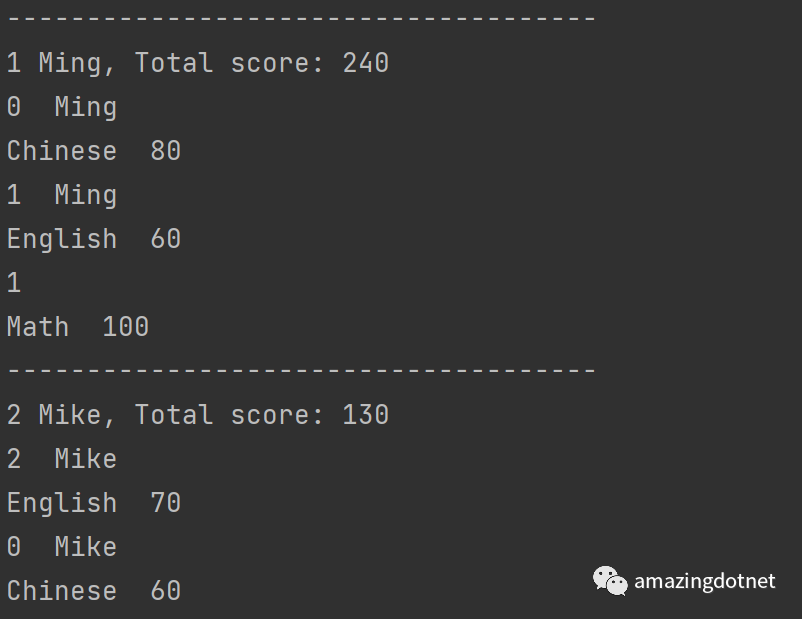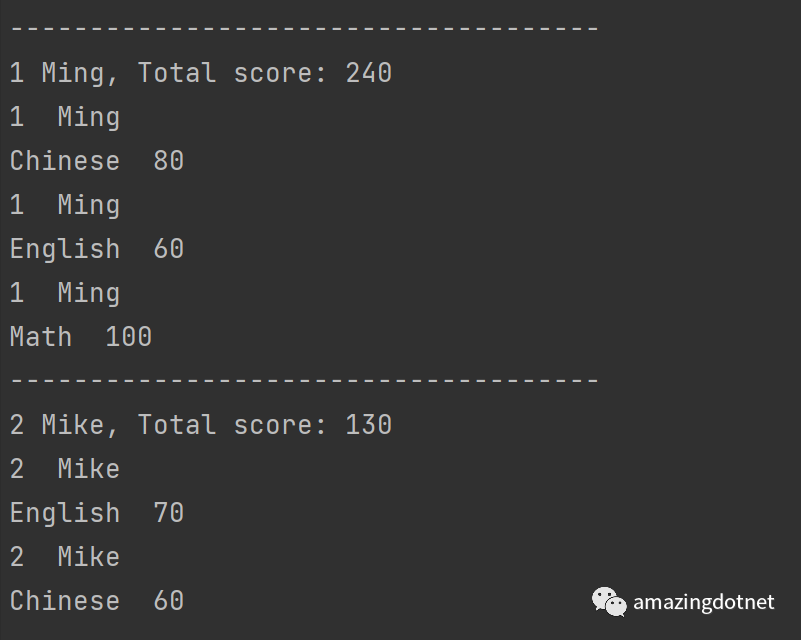Intro
在我们的系统里有些数据可能会有问题,数据源头不在我们这里,数据不好修复,在做 GroupBy 的时候就会很痛苦,默认的 group by 会依赖于 HashCode ,而某些场景下 HashCode 可能并不太大做统一,所以扩展了一个不依赖 HashCode,只需要考虑相等性比较的一个 GroupBy
Sample
我们有下面这样的一些数据.
var students = new StudentResult[]
{
new() { StudentName = "Ming", CourseName = "Chinese", Score = 80, },
new()
{
StudentId = 1, StudentName = "Ming", CourseName = "English", Score = 60,
},
new()
{
StudentId = 2, StudentName = "Mike", CourseName = "English", Score = 70,
},
new() { StudentId = 1, CourseName = "Math", Score = 100, },
new()
{
StudentName = "Mike", CourseName = "Chinese", Score = 60,
},
};
这些数据是一些学生成绩,但是学生的信息不全,学生信息可能有 Id,可能有 Name,假设每个学生的 Id 和 Name 都是唯一的,不会重复,将上面的信息按学生分组并获取每个学生的总分数,你会怎么实现呢?
Implement
默认的实现依赖于 HashCode,实现源码可以参考文末链接,而多个字段的 HashCode 比较难以统一,所以就想着自己扩展 GroupBy,实现代码如下:
GroupBy 的返回值是 IEnumerable<IGrouping<TKey, T>>,默认的 Grouping 的 Add 方法是 internal的
我们先自定义一个简单 IGrouping,实现代码如下:
private sealed class Grouping<TKey, T> : IGrouping<TKey, T>
{
private readonly List<T> _items = new();
public Grouping(TKey key) => Key = key ?? throw new ArgumentNullException(nameof(key));
public TKey Key { get; }
public void Add(T t) => _items.Add(t);
public int Count => _items.Count;
public IEnumerator<T> GetEnumerator()
{
return _items.GetEnumerator();
}
IEnumerator IEnumerable.GetEnumerator()
{
return GetEnumerator();
}
}
接着来实现我们的按相等性比较的 GroupBy,实现如下:
public static IEnumerable<IGrouping<TKey, T>> GroupByEquality<T, TKey>(this IEnumerable<T> source,
Func<T, TKey> keySelector,
Func<TKey, TKey, bool> comparer)
{
var groups = new List<Grouping<TKey, T>>();
foreach (var item in source)
{
var key = keySelector(item);
var group = groups.FirstOrDefault(x => comparer(x.Key, key));
if (group is null)
{
group = new Grouping<TKey, T>(key);
group.List.Add(item);
groups.Add(group);
}
else
{
keyAction?.Invoke(group.Key, item);
group.List.Add(item);
}
}
return groups;
}
我们来测试一下我们的 GroupBy,测试代码:
var groups = students.GroupByEquality(x => new Student() { Id = x.StudentId, Name = x.StudentName },
(s1, s2) => s1.Id == s2.Id || s1.Name == s2.Name, (k, x) =>
{
if (k.Id <= 0 && x.StudentId > 0)
{
k.Id = x.StudentId;
}
if (k.Name.IsNullOrEmpty() && x.StudentName.IsNotNullOrEmpty())
{
k.Name = x.StudentName;
}
});
foreach (var group in groups)
{
Console.WriteLine("-------------------------------------");
Console.WriteLine($"{group.Key.Id} {group.Key.Name}, Total score: {group.Sum(x => x.Score)}");
foreach (var result in group)
{
Console.WriteLine($"{result.StudentId} {result.StudentName}\n{result.CourseName} {result.Score}");
}
}
输出结果如下:

可以看到前面的数据分成了两组,但是可以看到的数据里仍然是信息不全的,我们可以稍微改进一下上面的方法,修改后如下:
public static IEnumerable<IGrouping<TKey, T>> GroupByEquality<T, TKey>(this IEnumerable<T> source,
Func<T, TKey> keySelector,
Func<TKey, TKey, bool> comparer,
Action<TKey, T>? keyAction = null, Action<T, TKey>? itemAction = null)
{
var groups = new List<Grouping<TKey, T>>();
foreach (var item in source)
{
var key = keySelector(item);
var group = groups.FirstOrDefault(x => comparer(x.Key, key));
if (group is null)
{
group = new Grouping<TKey, T>(key)
{
item
};
groups.Add(group);
}
else
{
keyAction?.Invoke(group.Key, item);
group.Add(item);
}
}
if (itemAction != null)
{
foreach (var group in groups.Where(g => g.Count > 1))
{
foreach (var item in group)
itemAction.Invoke(item, group.Key);
}
}
return groups;
}
增加了一个 itemAction,这里加了一个 group count 大于 1 的条件,因为只有一个元素的时候,key 一定是来自这个元素不需要更新,所以加了一个条件,再来修改一下我们调用的示例:
var groups = students.GroupByEquality(x => new Student() { Id = x.StudentId, Name = x.StudentName },
(s1, s2) => s1.Id == s2.Id || s1.Name == s2.Name, (k, x) =>
{
if (k.Id <= 0 && x.StudentId > 0)
{
k.Id = x.StudentId;
}
if (k.Name.IsNullOrEmpty() && x.StudentName.IsNotNullOrEmpty())
{
k.Name = x.StudentName;
}
}, (x, k) =>
{
if (k.Id > 0 && x.StudentId <= 0)
{
x.StudentId = k.Id;
}
if (k.Name.IsNotNullOrEmpty() && x.StudentName.IsNullOrEmpty())
{
x.StudentName = k.Name;
}
});
foreach (var group in groups)
{
Console.WriteLine("-------------------------------------");
Console.WriteLine($"{group.Key.Id} {group.Key.Name}, Total score: {group.Sum(x => x.Score)}");
foreach (var result in group)
{
Console.WriteLine($"{result.StudentId} {result.StudentName}\n{result.CourseName} {result.Score}");
}
}
增加了 itemAction,在最后将 key 的信息再同步回 group 内的各个数据,此时我们再来运行一下我们的示例,结果如下:

可以看到现在我们的数据就都有 Id 和 Name 了~~
More
我们也可以增加一个 IEqualityComparer 的重载来支持自定义的 comparer
public static IEnumerable<IGrouping<TKey, T>> GroupByEquality<T, TKey>(this IEnumerable<T> source,
Func<T, TKey> keySelector,
IEqualityComparer<TKey> keyComparer,
Action<TKey, T>? keyAction = null, Action<T, TKey>? itemAction = null) where TKey : notnull
{
return GroupByEquality(source, keySelector, keyComparer.Equals, keyAction, itemAction);
} 